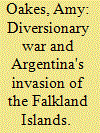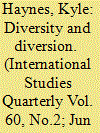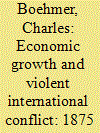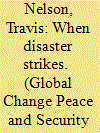|
|
|
Sort Order |
|
|
|
Items / Page
|
|
|
|
|
|
|
| Srl | Item |
| 1 |
ID:
076995


|
|
|
|
|
| Publication |
2006.
|
| Summary/Abstract |
Why do states launch diversionary conflicts? In particular, why did Argentina invade the Falkland Islands in 1982? The existing literature tends to analyze diversionary conflict by examining the direct relationship between domestic unrest (the independent variable) and the use of force (the dependent variable). But such an approach ignores critical variables that shape the likelihood of diversionary conflict. When states face domestic unrest, they have a number of options: they can launch a diversionary conflict, they can reform, or they can repress. We therefore need to consider which variables alter the attractiveness of each of these options, employing what I term "the policy alternatives approach." The decision to launch a diversionary conflict may result more from the inability to reform or repress, than it does from the perceived utility of using force to rally the public. An important variable that facilitates or constrains a state's ability to reform or repress is state extractive capacity. The policy alternatives approach enables a new explanation for the invasion of the Falklands, based on the interaction between domestic unrest and low state extractive capacity, and also highlights a number of other variables that may explain diversionary conflicts.
|
|
|
|
|
|
|
|
|
|
|
|
|
|
|
|
| 2 |
ID:
146198


|
|
|
|
|
| Summary/Abstract |
How does a state’s ethnic composition affect its propensity to engage in diversionary conflicts? Recent empirical work examines the political conditions under which domestic unrest compels an embattled leader to initiate conflict abroad. We remain uncertain, however, of what social or demographic characteristics make states particularly prone to diversionary behavior. This article tries to address this gap, examining whether a state’s ethnic structure conditions its leader’s response to domestic discontent. Combining the expansive literatures on ethnic politics and diversionary war yields conflicting expectations here. I find that ethnically fragmented states are significantly more prone to initiating diversionary conflicts, and I show that the greater availability of “conflict opportunities” resulting from transborder ethnic-kin groups, in part, drives this effect. A brief case study illustrates these dynamics.
|
|
|
|
|
|
|
|
|
|
|
|
|
|
|
|
| 3 |
ID:
096268


|
|
|
|
|
| Publication |
2010.
|
| Summary/Abstract |
Are states with growing economies more likely to become involved in violent interstate conflicts? This project examines whether economic growth increases international conflict using a global sample of states from 1875-1999. The theory argues that multi-year economic growth increases the resolve of state leaders to reciprocate and escalate militarized interstate conflicts, thus increasing the occurrence of fatalities or war. The results show that economic growth, but not growth of military expenditures, raises the risk of violent interstate conflicts. The results do not support the proposition that economic slowdowns result in violent interstate conflicts.
|
|
|
|
|
|
|
|
|
|
|
|
|
|
|
|
| 4 |
ID:
160239


|
|
|
|
|
| Summary/Abstract |
Diversionary conflict theorists assert that leaders can become more popular at home by pursuing conflict abroad. At first glance this claim appears counterintuitive in light of the hardship conflict often imposes on ordinary citizens. Relying on social identity theory (SIT), I deduce two hypotheses to help explain why conflict can increase popular support for leaders. First, conflict with an outgroup can make people identify more strongly with their ingroup. Second, stronger ingroup identification can lead to increased support for leaders inside the group. The second part of the article applies these two hypotheses to Russia's seizure of Crimea in early 2014. Attitude surveys show that the Crimea conflict increased national pride among Russians while support for President Vladimir Putin rose dramatically, and they suggest that the two processes were causally linked. These findings support the article's two hypotheses.
|
|
|
|
|
|
|
|
|
|
|
|
|
|
|
|
| 5 |
ID:
096681


|
|
|
|
|
| Publication |
2010.
|
| Summary/Abstract |
This article asks under what circumstances natural disaster can lead to interstate conflict initiation. Through an analysis of all major earthquakes, floods, storms, and tsunamis between 1950 and 2006, I find that serious disaster increases the general likelihood of conflict initiation, and I reach two key conclusions about the specific causal mechanisms driving post-disaster conflict. First, I show that there is not a single instance of a rival or opponent state taking the opportunity to initiate military conflict in the aftermath of serious disaster. This finding supports the developing literature on 'disaster diplomacy'. Second, there are, however, cases in which states with a recent history of significant civil disruption initiate such conflicts themselves. In these situations, disaster can contribute to the conflict environment and can make conflict initiation significantly more likely. I find that, counter-intuitively, it is the very states most vulnerable and most weakened by disaster that are likely to initiate conflict in a post-disaster environment.
|
|
|
|
|
|
|
|
|
|
|
|
|
|
|
|
|
|
|
|
|